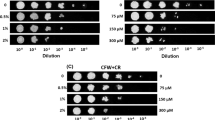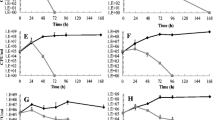Abstract
A mesophilic wine yeast, Saccharomyces cerevisiae CSIR Y217 K − R − was subjected to the K2 killer effect of Saccharomyces cerevisiae T206 K + R + in a liquid grape medium. The lethal effect of the K2 mycoviral toxin was confirmed by methylene blue staining. Scanning electron microscopy of cells from challenge experiments revealed rippled cell surfaces, accompanied by cracks and pores, while those unaffected by the toxin, as in the control experiments, showed a smooth surface. Transmission electron microscopy revealed that the toxin damaged the cell wall structure and perturbed cytoplasmic membranes to a limited extent.
Similar content being viewed by others
References
Ahmed, A, Sesti F, Ilan N, Shih TM, Sturley SL & Goldstein SAN (1999) A molecular target for viral killer toxin: TOK1 potassium channels. Cell 99: 283–291
Bussey H (1991) K1 killer toxin, a pore-forming protein from yeast. Mol. Microbiol. 5: 2339–2343
Carrau FM, Neirotti E & Gioia O (1993) Stuck wine fermentations: Effect of killer/ sensitive yeast interactions. J. Ferment. Bioeng. 76: 67–69
Franken DB, Ariatti M, Pretorius IS & Gupthar AS (1998) Genetic and fermentation properties of the K2 killer yeast, Saccharomyces cerevisiae T206. Antonie van Leeuwenhoek 73: 263–269
Hutchins K & Bussey H (1983) Cell wall receptor for yeast killer toxin: Involvement of (1→6)-β-D-glucan. J. Bacteriol. 154: 161–169
Jacobs CJ & Van Vuuren HJJ (1991) Effects of different killer yeasts on wine fermentations. Am. J. Enol. Vitic. 42: 295–300
Longo E, Velázquez JB, Cansado J, Calo P & Villa TG (1990) Role of killer effect in fermentations conducted by mixed cultures of Saccharomyces cerevisiae. FEMS Microbiol. Lett. 71: 331–336
Martinac B, Zhu H, Kubalski A, Zhou XL, Culbertson M, Bussey H & Kung C (1990) Yeast K1 killer toxin forms ion channels in sensitive yeast spheroplasts and in artificial liposomes. Proc. Natl. Acad. Sci. 87: 6228–6232.
Osumi M (1998) The ultrastructure of yeast: cell wall structure and formation. Micron 29: 207–233
Reynolds ES (1963) The use of lead citrate at high pH as an electron opaque stain in electron microscopy. J. Cell. Biol. 17: 208–212
Spurr AR (1969) A low viscosity epoxy resin embedding medium for electron microscopy. J. Ultrastruct. Res. 26: 31–34
Starmer WT, Ganter PF, Aberdeen V, Lachance M-A & Phaff HF (1987) The ecological role of killer yeasts in natural communities of yeast. Can. J. Microbiol. 33: 783–796
Van Vuuren HJJ & Jacobs CJ (1992) Killer yeasts in the wine industry: A review. Am. J. Enol. Vitic. 43: 119–128
Van Vuuren HJJ & Wingfield BD (1986) Killer yeasts-cause of stuck fermentations in a wine cellar. S. Afr. J. Enol. Vitic. 7: 113–118
Author information
Authors and Affiliations
Corresponding author
Rights and permissions
About this article
Cite this article
Vadasz, A., Jagganath, D., Pretorius, I. et al. Electron microscopy of the K2 killer effect of Saccharomyces cerevisiae T206 on a mesophilic wine yeast. Antonie Van Leeuwenhoek 78, 117–122 (2000). https://doi.org/10.1023/A:1026588220367
Issue Date:
DOI: https://doi.org/10.1023/A:1026588220367




